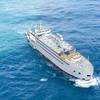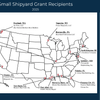U.S. Senator Patty Murray joined with TSA, Coast Guard, Customs, and port officials to demonstrate a new port security initiative that improves the security of cargo entering the United States while maintaining the efficiency of international commerce and transportation. While the majority of the post-September 11th security improvements have focused on airports and borders, 6 million containers enter U.S. ports annually, including 1.8 million into the Ports of Seattle and Tacoma.
"In Washington state, seaports are the lifeblood of our region's economy. Our ports move billions of dollars of goods each year and generate tens of thousands of good-paying, family-wage jobs across our state," Murray said. "Improving security without undermining efficiency is critical to the economic health of our region."
As Chair of the Senate Transportation Appropriations Subcommittee, Senator Murray established Operation Safe Commerce, to help improve the security of cargo by enabling U.S.-bound containers that are inspected overseas to be electronically sealed and tracked through a U.S. port, and on to its final destination. Murray secured $28 million for the pilot program to improve cargo security at the nation's three largest container ports: New York/New Jersey, California-Long Beach, and Seattle-Tacoma.
Today at the Port of Seattle, Murray demonstrated how this initiative will work by opening a container that had just arrived in the Port, and showing how the electronic tracking device helps authorities know what the container holds and where it has been. The device can also determine whether the container has been tampered with while en route to the U.S.
"This pilot program will allow our nation's three largest ports - including Seattle and Tacoma - to know more about what is inside the millions of containers entering our ports. Operation Safe Commerce will help lay the foundation for a new national port security regime," Murray continued.
The initiative represents the first time that an end-to-end security procedure for commercial cargo has been implemented in the U.S. and represents one of the first concrete measures taken by U.S. ports to improve port security.
Murray was joined by:
- Rear Adm. Errol Brown, District Commander, 13th Coast Guard District
- Tom Harry, Director Northwest/Great Plains Customs Management Center, U.S. Customs Service
- Steven Froehlich, Director of Stakeholder Relations for Maritime and Land Security, TSA
- Mic Dinsmore, CEO Port of Seattle
- Timothy J. Farrell, Dep. E.D., Port of Tacoma
Sponsored Content
Safer Starts Here: Build Ships, Protect Crews

Featured videos

Maritime Energy Transition: Cummins Focuses on Methanol

Meet the Volvo Penta IPS Electric (E)

Efficient Maritime Operations Transcend Data; Intelligence is Key
Subscribe for
Maritime Reporter E-News
Maritime Reporter E-News is the maritime industry's largest circulation and most authoritative ENews Service, delivered to your Email five times per week









